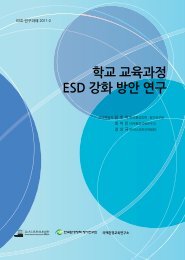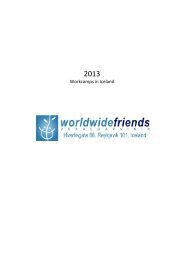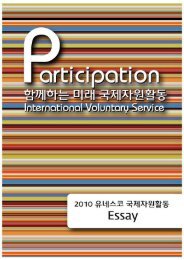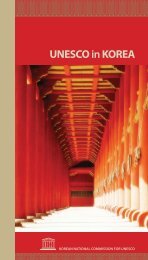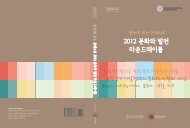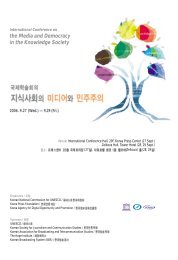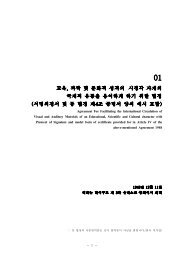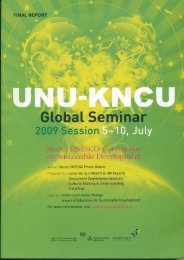DMZ ì¼ì ìí ííì ê´ë¦¬ë¥¼ ìí êµì 컨í¼ë°ì¤ - ì ë¤ì¤ì½íêµììí
DMZ ì¼ì ìí ííì ê´ë¦¬ë¥¼ ìí êµì 컨í¼ë°ì¤ - ì ë¤ì¤ì½íêµììí
DMZ ì¼ì ìí ííì ê´ë¦¬ë¥¼ ìí êµì 컨í¼ë°ì¤ - ì ë¤ì¤ì½íêµììí
Create successful ePaper yourself
Turn your PDF publications into a flip-book with our unique Google optimized e-Paper software.
<strong>DMZ</strong> 일원 생태ㆍ평화적 관리를 위한 국제컨퍼런스<br />
local development. Obviously, the local development issues concerning <strong>DMZ</strong> must be<br />
brought into broader national context for discussion.<br />
There are already well established knowledge bases worldwide concerning local<br />
participation in biodiversity conservation and sustainable use. Among these are numerous<br />
interesting cases and lessons learnt from UNESCO’s practices on how to reconcile<br />
conservation and local development interest, which may in one way or another benefit the<br />
discussions concerning <strong>DMZ</strong>. Examples include those sites involved trans-boundary<br />
conservation, tourism development programmes, ecosystem rehabilitation and restoration,<br />
private sector engagement in conservation, serial nominations and developing-testing new<br />
management zonation schemes. The guiding principles from UNESCO instruments, such as<br />
Seville Strategy and Madrid Action Plan, are of particular relevance.<br />
It is worth noting the following overall lessons learned from UNESCO practices in<br />
in-situ conservation and development over the last decades a) biodiversity protection,<br />
conservation and rehabilitation are shown as the integral components of socio-economic<br />
development of the region containing protected areas, thus changing the notion of economic<br />
development and biodiversity conservation are separately shown on the two sides of one<br />
‘coin’ – they are on both sides of the ‘coin’ b) conservation and development effort can<br />
not be sustainable and will miss its human meaning if without genuine local participation;<br />
c) Such local participation cannot be fulfilled without understanding social and cultural<br />
contexts and values of the communities concerned.<br />
As <strong>DMZ</strong> is concerned, more effort will be needed to look at the historical, political,<br />
social and cultural aspects of the area, in addition to the continued scientific work on<br />
biological diversity and protection. For conservation and peaceful use of the <strong>DMZ</strong> area, it<br />
is critical to understand, articulate and recognize the diverse values of the area, being<br />
tangibles and intangible. In this regards, IUCNmaterials on conservation values and<br />
UNESCO discussions on the intangible values of conservation properties need particular<br />
attention.<br />
It is still expected that Biosphere Reserve can one day become the platform for<br />
conservation and peaceful use of <strong>DMZ</strong>, as Biosphere Reserves are used globally as learning<br />
sites for sustainable development. Such application of Biosphere Reserve can start from the<br />
side of ROK first and eventually for both sides of <strong>DMZ</strong>. As is known, Biosphere Reserves<br />
are ecosystems internationally recognized under MAB to explore how human societies can<br />
reconcile the conservation of biodiversity, the quest for economic and social development<br />
and the maintenance of associated cultural values and meanings. Biosphere Reserves are<br />
thus to protect and promote both natural and cultural diversity, both are representative at<br />
74 ❙ <strong>DMZ</strong> 일원의 생태⋅평화⋅지역발전



